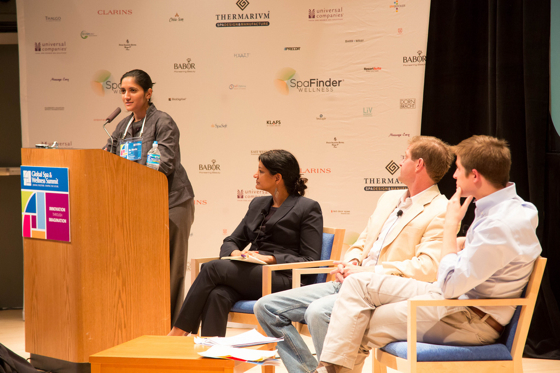The Global Spa & Wellness Summit, held in Aspen, Colorado, in collaboration with think-tank the Aspen Institute, debated the most innovative, imaginative ways forward for the worldwide spa and wellness industry.
Although the conference is invitation-only, its stated mission is to support the growth of all 75,000 spas worldwide. So, the GSWS has made PowerPoints, session notes, video and numerous research reports available here.

Dozens of innovative spa/wellness industry opportunities were presented, and hot-button ones included:
- Spas as Telomere Health Centers: Telomeres are the caps of human’s chromosomes, and medical studies increasingly reveal that their health/length is a crucial window into a person’s actual “cellular age,” and a predictor of diseases like cancer and heart disease. Studies also show that stress reduction, a healthy diet, exercise and mindfulness practices can lengthen telomeres – exactly what spas provide. With telomere testing launching to the general population in the next year, the tracking of the impact of various spa/wellness therapies on telomere health could become a reality. And as the evidence mounts that core spa/wellness approaches positively modify telomere health, a natural industry opportunity arises.
- Mental wellness and happiness, brain performance and creativity: From top doctors on Aspen Institute’s Health Innovation panel, to celebrity Mariel Hemingway, a recurrent topic was spas’ major (mostly unleveraged) opportunity in mental wellness, given that in places like America, 50% of people suffer from stress and one in eight from depression. And with the “science of happiness” an increasingly hot topic (i.e., happy people are proven to have better physical health, earn more, etc.), spas, as the healing industry uniquely focused on feeling good/pleasure, have fresh opportunities within their traditional focus. A presentation on the latest in brain science also suggested that spas could be re-perceived as places where creativity best gets accomplished, given that stress is the top threat to the brain’s “innovative thinking” center. Delegates learned that stress-reduction and mindfulness approaches can actually “re-wire” clients’ brains and create peak performance thinking conditions. (So, if spas have traditionally been places of escape from work/thinking, a new opportunity to reimagine them as creativity/thinking “labs” now arises.
- Wellness coaching: Given the global “diabesity” pandemic, traditional health education is clearly not working, while medical studies show coaching is the superior model to elicit long-term behavioral change. While there are already roughly 100,000 coaches in the U.S., the profession worldwide remains at the early, chaotic stage. But standards are coming (like the American National Consortium for Credentialing Health & Wellness Coaches), and local coaching “networks” are being formed. Integrating wellness coaching represents a major industry opportunity, but spas need to move beyond their traditionally short-term thinking, to focus on long-term client results and programs.
- Employee wellness: With employer-provided healthcare costs spiraling out of control (in the U.S. they will double in10 years), and hundreds of studies showing employee wellness programs reduce costs and boost productivity, two in three larger businesses worldwide have now embraced a formal employee wellness strategy. And with stress-reduction the leading employer goal worldwide, spas are a very natural “fit” for the US$30 billion-plus workplace wellness industry. But the industry needs to better communicate their total health-focused package (i.e., massage, fitness, meditation, yoga and nutritional counseling, etc.), along with their unique status as the healthy, desirable incentive to keep employees on healthy regimes.
- Technology, gadgets and gaming: New technologies and the industry opportunities they present were a key topic: from Google’s head of retail explaining that spas need to better embrace all the spawning, cheap and easy customer communications technologies available, whether incentivizing people to “check-in” at places like Facebook or foursquare; creating YouTube videos of facilities, treatments and products; or ensuring easy online booking. Opportunities in the new worlds of wellness gaming and gadgets (from biometric monitoring devices to mobile apps) – and in other emerging online spa-client engagement platforms that forge more ongoing, supportive connections – were also hot topics.
- Empowering willpower: The latest from the science of willpower was presented, revealing that a) willpower is a limited brain resource, like a muscle that gets fatigued b) creating habits works best c) tackling multiple behavior changes too fast leads to failure, and d) that glucose is critical for the brain to exercise self-control – severely questioning “crash,” short-window lifestyle change or dieting models. Spas have a new opportunity to square their programs with the self-control science (i.e., removing temptations, not over-taxing client willpower/decision-making and implementing mindfulness programs proven to build this “muscle”), to become the place where truly sustainable health changes and weight loss can get accomplished.
- Reaching younger people: Numerous medical experts argued that the industry needs to focus far more on children, and reach people far younger, given that lifestyle behaviors (diet, exercise) begin cementing by age 2. Spas have a largely untapped opportunity to create more children’s programming specifically focused on developing solid, lifelong wellness habits.
- Community: Medical experts also explained how, despite (or perhaps because of) our “wired” world, people are suffering from loneliness at unprecedented rates, and that isolation is a disease that leads to serious health problems. Spas have a natural opportunity (as trusted places of “touch”) to address this problem creatively, but haven’t yet capitalized on their potential as places of true community.
“Spas have got to stop selling a checklist of isolated services, and start offering a total way to live. And when they become more complete and accessible wellness advocates, educators and providers, this industry could go from being mere enclaves, to beachheads, of innovation,” said Dr. Joseph Hutter, fellow at the Institute for Health Care Delivery Research.

